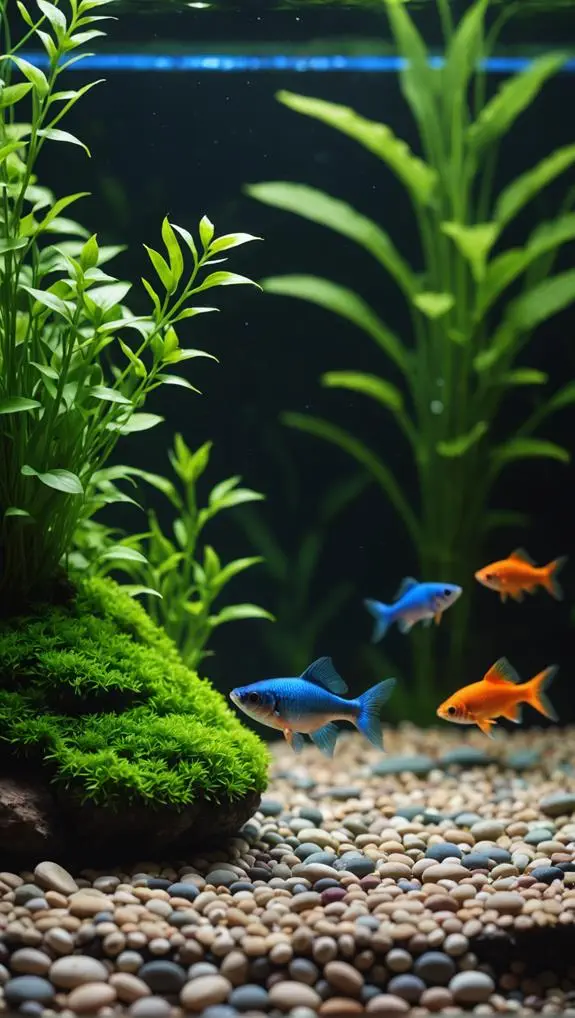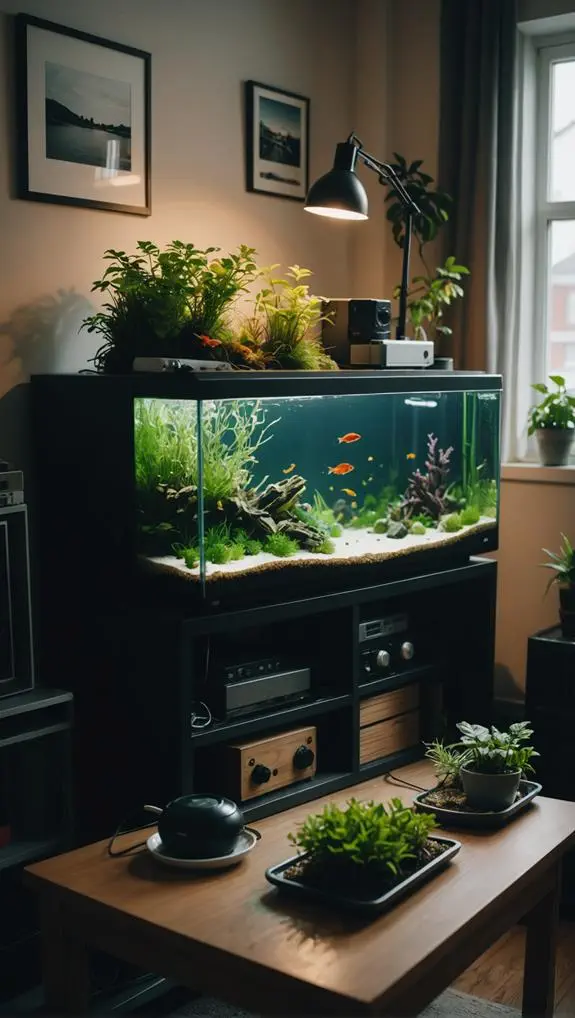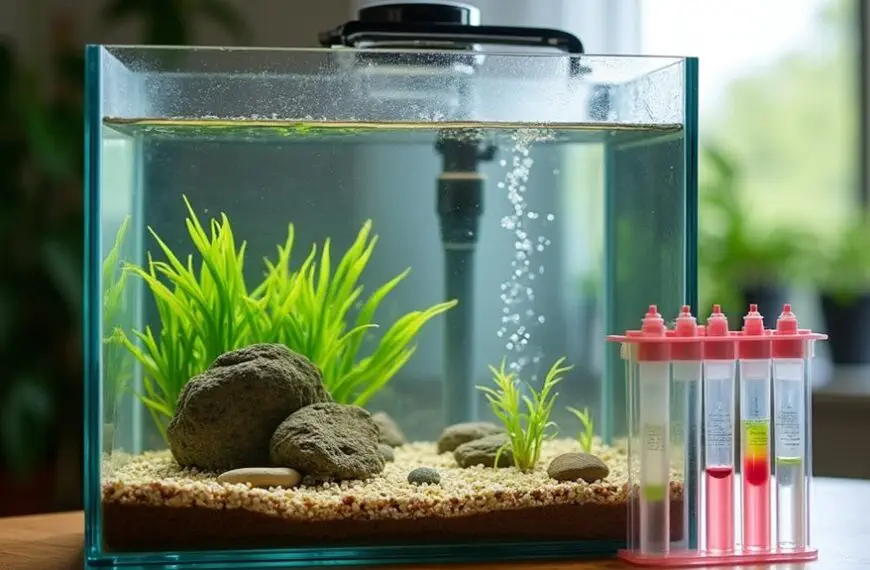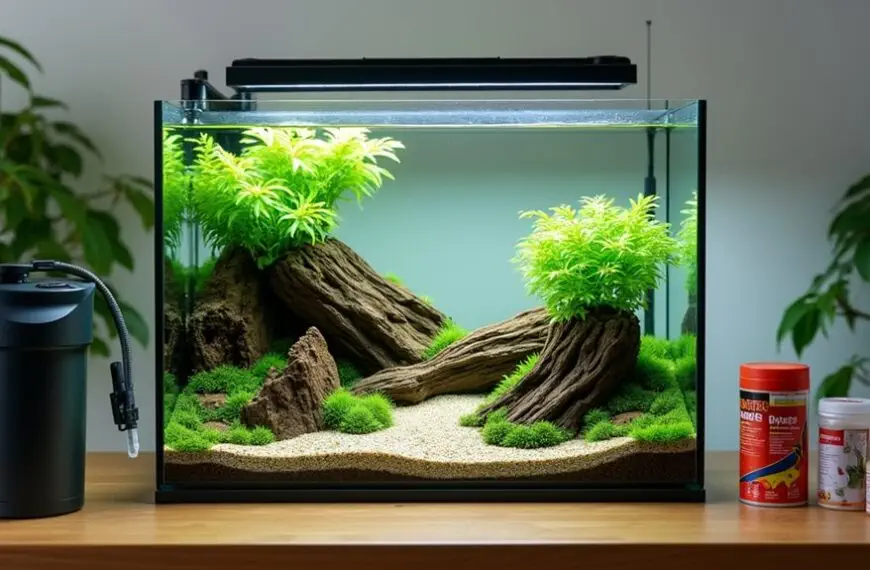Setting up a fish tank in a small space can be a blast! First, pick the right tank size—5 to 10 gallons is perfect for nano fish. Don't skimp on filtration; a good filter keeps the water fresh and your fish happy. Use energy-efficient LED lights for low maintenance and healthy plants. Speaking of plants, choose easy ones like Java fern or Christmas moss to improve water quality. Avoid overcrowding your tank—fish need their space. And remember, a little aquascaping can make your tank a stunning centerpiece. Stick around, and you'll uncover even more handy tips to make your aquatic adventure a success!
Contents
Choosing the Right Tank Size
When it comes to choosing the right tank size for your fish, size really matters. You want to create a perfect tank setup that keeps your aquatic friends happy and healthy.
Smaller tanks, while charming, can quickly throw water quality out of balance. This can lead to stress for your small fish and require more frequent maintenance. Trust me, nobody wants that extra chore!
If you're thinking about tiny fish like nano species, a tank between 5 to 10 gallons can be ideal. But if you've got larger fish in mind, aim for at least 20 gallons or more.
Remember, every fish has its own size requirements, and overcrowding can lead to disaster.
Choosing the right tank size means you'll maintain stable water temperatures and quality more easily. Plus, adjustable heaters fit snugly into those compact spaces.
Importance of Filtration Systems
Ensuring a clean and healthy environment for your fish hinges on the effectiveness of your filtration system. In small tanks, where water volume is limited, even tiny imbalances can threaten your fish's well-being. That's why investing in the right filtration systems is crucial.
You've got options like sponge filters, hang-on-back filters, and internal filters, each tailored to meet the unique needs of your aquarium.
But remember, filtration alone isn't enough! Regular water changes play a vital role in maintaining water quality. Small ecosystems can quickly accumulate toxins, so keeping up with your maintenance routine is essential.
It's like giving your fish a spa day!
Don't forget to monitor the bioload, too. Overcrowding can compromise your filtration system's efficiency. You want your aquatic friends to thrive, right?
So, choose a filtration system that fits your tank size and keep an eye on the number of fish you have.
With a well-maintained filtration system and routine water changes, you're setting the stage for a balanced aquatic ecosystem. Your fish will thank you, and you'll enjoy a vibrant underwater world!
Optimal Lighting for Small Aquariums

When it comes to lighting your small aquarium, you're in for a treat with LED lights—they're energy-efficient and keep your water temperature stable.
The right light spectrum is crucial for your plants, helping them grow while keeping your fish vibrant and happy.
Plus, with a little planning on how long and how bright your lights shine, you'll keep pesky algae at bay and create a lively underwater world that's a joy to watch.
Light Spectrum Importance
The right light spectrum is vital for the health of your small aquarium, as it directly influences both plant growth and fish vitality.
In a planted aquarium, you'll want a spectrum between 6500K and 8000K to keep your aquatic plants thriving. Remember, different wavelengths support different processes; blue light promotes photosynthesis like a caffeine boost for plants, while red light helps them grow and flower beautifully.
Now, let's talk about energy efficiency. LED lights are your best friends here! They not only save you money on your electric bill but also last a long time, which means less hassle for you.
Plus, many LEDs let you adjust the light intensity and spectrum settings, so you can tailor the setup to your fish and plants' needs.
It's essential to monitor how long your lights are on—aim for 8 to 12 hours a day. This practice helps prevent pesky algae overgrowth and keeps your aquatic oasis in balance.
A well-balanced lighting setup adds visual appeal, showcasing the vibrant colors of your fish and plants. After all, a happy tank makes for happy fish!
LED Energy Efficiency
Switching to LED lighting is a game-changer for small aquariums, as it dramatically boosts energy efficiency. You'll be amazed to learn that LED lights consume up to 80% less energy than traditional incandescent bulbs. That means more money in your pocket for fish food and decorations!
Plus, these lights provide just the right amount of illumination for your aquatic environment.
One of the coolest features of LED lights is their adjustable intensity. This allows you to customize light levels for specific fish and plants, ensuring they thrive and show off their vibrant colors.
And let's not forget about longevity—LEDs can last up to 25,000 hours, so you won't be replacing them anytime soon. This is perfect for those low-maintenance setups we all love.
Using LED lighting also supports effective photosynthesis in live plants, creating a balanced ecosystem. This not only enhances water quality but keeps your fish happy and healthy too.
Plant Growth Enhancement
To achieve optimal plant growth in small aquariums, utilizing energy-efficient LED lighting is key. These lights not only provide the right spectrum for photosynthesis but also help you save on energy bills—your wallet will thank you!
Make sure to adjust the intensity based on the light requirements of your plants. Most low to medium light plants thrive at 20-40 PAR, so keep that in mind when choosing your setup.
A proper lighting schedule is essential too. Aim for 8 to 12 hours of light each day. This helps prevent pesky algae from crashing the party while keeping your plants happy and healthy!
And don't forget about your CO2 setup. Adding a CO2 injection system can work wonders, especially in densely planted tanks. It gives your plants the carbon they crave for robust growth.
Lastly, regularly check your water parameters, like pH and nutrient levels. This ensures your plants are living in their best environment, resulting in a vibrant and thriving aquarium.
With the right lighting and care, you'll be on your way to creating a beautiful underwater oasis that both you and your plants will love!
Decorating With Aquascaping
When it comes to decorating with aquascaping, think of your fish tank as a mini jungle waiting to be explored!
By mixing live plants and using cool elements like driftwood and rocks, you can create a stunning landscape that not only looks great but also keeps your fish happy and healthy.
With the right lighting to make those vibrant colors pop, your small space can feel like a vibrant underwater paradise!
Aesthetic Plant Integration
How can you transform a small fish tank into a stunning aquatic landscape? By integrating live plants! Not only do they beautify your tank, but they also play a crucial role in maintaining water quality, creating a healthier habitat for your fish.
Choose low-maintenance aquatic plants like Java fern and Anubias, which thrive in small spaces without dominating the scene.
To add depth and structure, consider using driftwood and rocks. These natural elements provide hiding spots for your fish and make the aquascape more dynamic.
Layer your plants in varying heights and textures to create visual interest. Remember, a little bit of balance goes a long way!
Regular trimming of your live plants is essential. It keeps them healthy and prevents overcrowding, ensuring both aesthetics and your fish's needs are met.
Think of it as a stylish haircut for your underwater friends—nobody wants a fish jungle!
Creative Focal Point Design
After enhancing your fish tank with aesthetic plant integration, it's time to elevate the overall design with creative focal points. Think of these focal points as the 'wow' factor in your aquarium. By adding elements like driftwood or unique rock formations, you can create stunning visual interest, making your small space feel larger and more inviting.
Plus, these features provide hiding spots for your fish, allowing them to feel safe and secure.
When you choose low-growing plants and utilize vertical space wisely, you'll create a lush, vibrant aquascape that won't crowd your tank. Mixing textures and colors—like smooth stones paired with rough driftwood—adds depth and keeps the eye engaged.
It's like decorating your home, but underwater!
Don't forget that a balanced aquascape not only boosts the beauty of your fish tanks but also improves water quality. Healthy plants contribute to a thriving ecosystem, creating beneficial interactions between your fish and their environment.
Low-Maintenance Fish Species

Setting up a small aquarium doesn't have to be complicated, especially when you choose low-maintenance fish species. For your freshwater tank, consider starting with Betta fish. These vibrant swimmers thrive alone and only need a minimum of 5 gallons of water.
If you're looking for a community feel, Neon tetras are hardy schooling fish that adapt well to small tanks, needing at least 10 gallons to showcase their lively colors.
Another excellent option is Endler's livebearers, which bring a splash of color and can comfortably live in spaces of 5-10 gallons with minimal care.
Zebra danios are also perfect for small tanks, as they're resilient and can handle various water conditions. They prefer to be in groups of at least five, needing a minimum of 10 gallons to thrive.
Lastly, don't overlook guppies! These charming little fish are prolific breeders and do well in groups in tanks as small as 5 gallons.
Plants That Thrive in Small Aquariums
In a small aquarium, selecting the right plants can significantly enhance both the aesthetics and the health of your tank. You want plants that thrive in small aquariums, and there are plenty of options that not only look great but also improve water quality.
Here are some fantastic choices:
- Java Fern: This hardy plant is low-maintenance and grows well in various conditions. Perfect for beginners!
- Water Sprite: A floating plant, it absorbs excess nutrients and provides shade, making it a cozy home for your fish.
- Cryptocoryne: This background plant uses vertical space efficiently, adding lush greenery to your limited space.
- Christmas Moss: Known for its vibrant appearance, it also offers surfaces for beneficial bacteria to thrive, boosting overall tank health.
Common Mistakes to Avoid

Small aquarium enthusiasts often make critical mistakes that can jeopardize their tank's health and beauty. One big error is overcrowding your small tank with too many fish. This leads to poor water quality and stressed-out fish. Stick to the recommended bioload limits for your species; it'll make a world of difference.
Another common pitfall is neglecting proper filtration. Without the right filter, your small freshwater tank can quickly turn into a toxic soup. Make sure you're choosing the right filter suited for your tank size.
Regular water changes are also a must. Failing to do this can cause harmful toxins to build up in your limited water volume, putting your fish and plants at risk.
And don't forget about your fish's specific needs! Ignoring their temperature, pH, and compatibility can lead to disaster.
Lastly, overlooking aquascaping and plant integration can diminish your tank's charm. Adding live plants isn't just pretty; it also helps improve water quality.
Frequently Asked Questions
Where Should a Fish Tank Be Placed in a Small Room?
When placing your fish tank, consider lighting considerations and furniture arrangement. Ensure it's accessible for maintenance while avoiding high-traffic areas. This way, you'll create a serene environment for both the fish and viewers.
How to Set up a Small Aquarium?
To set up a small aquarium, choose fish that thrive in limited space, invest in quality tank filtration, and prioritize regular aquarium maintenance. This ensures a healthy environment that benefits both your fish and those who admire them.
How Do You Layout an Aquarium?
To layout your aquarium, consider the dimensions and filtration requirements first. Arrange plants and décor for balance, ensuring proper lighting options enhance both aesthetics and fish health. This way, you'll create a thriving aquatic environment.
What Is the Best Placement for a Fish Tank?
When choosing the best placement for your fish tank, consider lighting options, tank materials, and fish compatibility. Position it away from direct sunlight and temperature fluctuations to ensure a healthy environment for your aquatic friends.
Final Thoughts
So, you're ready to dive into the world of small aquariums! With the right tank size, a solid filtration system, and some lively plants, your little underwater paradise will flourish. Remember, it's all about balance—like a fish doing the cha-cha in a tiny space! Avoid common pitfalls, choose low-maintenance fish, and let your creativity shine through aquascaping. Soon, you'll have a vibrant aquatic haven that brings joy to your day. Happy fishkeeping!












